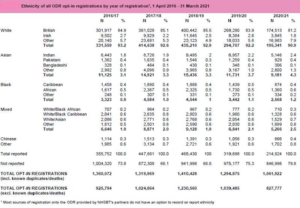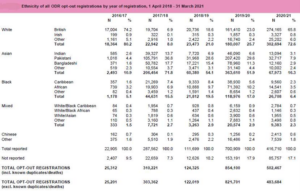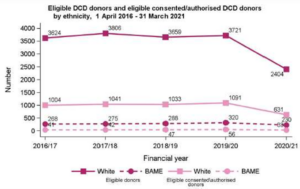
This article provides detailed information how COVID- 19 affected organ donation and transplantation in BAME community (non-white communities in UK), which is already hesitant to sign up for NHS Organ Donation Register due to religious reasons or decreased awareness of the topic. A number of educational public forums have been held across UK in the past years, incorporating religious leaders to educate and clear the confusions regarding religious permissibility. There is a significant shortage of organ donors from Black, Asian and Mixed race Ethnic (BAME) groups in the United Kingdom (UK) despite numerous public education campaigns. BAME groups represent 14% of the British population, (Office for National Statistics, 2011a) but only 7% of the opt-in NHS Organ Donation Register, and 31% of patients on the transplant waiting list (NHS Blood and Transplant, 2019)1
The data evaluated includes registrations on the NHS Organ Donor Register (ODR), deceased and living organ donors, transplant recipients, patients and deaths on the transplant lists and waiting times to transplant. Developments in relation to potential organ donors, including donation consent/authorisation rates, are also reported. The COVID-19 pandemic has led to unique challenges for organ donation and transplantation. Apprehensions about the ability to care for transplant recipients, as the resources were being used for patients in the pandemic, and the risk versus benefit for immune- compromised transplant recipients, have led to a major reduction in the number of organ transplants carried out.
From 1stApril, 2020 to 31st March, 2021, the population of UK was approximately 7,000,000. Total UK deaths were approx. 680,000. Out of these, potential BAME donors were 849 and actual BAME donors were 146 (including 62 living donors). However, the number of BAME transplants were 767 and waiting list was found to be 1237. The main reasons BAME families gave for declining consent/authorisation for organ donation were that they felt it was against their religious/cultural beliefs or they were unsure whether the patient would have agreed to donation. Survey results of BAME communities show that not knowing enough about organ donation is also a major barrier to organ donation2.
The number of BAME deceased organ donors fell by 25% from 112 in 2019/20 to 84 in 2020/21. The number of BAME living donors had remained at approx. 140-160 per year between 2016/17 a d 2019/20, representing 14% of all living organ donors. COVID-19 also had an impact on living donation with BAME living donors falling by 61% to 62 donors in 2020/21. The number of transplants in BAME people had increased by 23% over the previous 4 years, representing 25% of all transplants. The numbers fell from 1204 in 2019/20 to 767 in 2020/21 due to COVID-192.
If we look at the Organ Donor Register (ODR) (Table 1.1), it shows us the number of opt-in registrations per year by ethnicity. In 2019/20, 92.2% of registrations with ethnicity were recorded by white people, 3.7% by Asians, 1.1% by Black and 2.1% by other mixed ethnicities.
After covid we can notice a significant decline in the percentage of registrations; in 2020/21, 90.9% of registrations with ethnicity recorded were by white people, 4.3% from Asian, 1.2% from black and 2.5% from mixed race2.
ODR also tells us the number of opt-out registrations per year by ethnicity from 1 April 2018 to 31 March 2021 (Table 1.2).In 2020/21, surprisingly the majority of opt-out registrations were among white people (72.6%), followed by Asian people (16%), black people (6.4%) and other mixed ethnicities (2.3%)2.
NHS Blood and Transplant (NHSBT) capture information about potential organ donors through the Potential Donor Audit (PDA). This audit is of all patient deaths in UK Intensive Care Units and emergency departments, excluding deaths on wards and any patients over 80 years of age. The PDA provides information about the organ donation process and identifies potential barriers to organ donation. The data shows that, due to COVID-19, the number of white and BAME eligible DBD (Donors after Brain Death) donors has fallen to 1098 and 277 respectively and that the number of white and BAME eligible consented/authorised DBD donors has fallen to 816 and 66 respectively.The impact of COVID-19 has also meant that both the number of eligible DCD (Donors after Circulatory Death) donors and eligible consented/authorised DCD donors have fallen considerably (Table 1.3)2.
Conclusion
We highlight the unmet need in raising awareness about organs donation in the BAME community to allow informed choice. The covid pandemic has exacerbated the pre-existing discrepancy of differential organ transplant rates between BAME and White patients. In keeping with the down turn in all transplant activity during the covid pandemic BAME patients have had a further negative impact and therefore a redoubling of efforts is required to bridge the gap and increase the rates of BAME organ transplant to be on par with White counterparts.We call for a new strategy of levelling up in BAME organ transplant rates to prevent health inequality.
References
- Ali, O.M.E., Gkekas, E., Ali, A.M.S. et al. Informing the UK Muslim Community on Organ Donation: Evaluating the Effect of a National Public Health Programme by Health Professionals and Faith Leaders. J Relig Health (2022). https://doi.org/10.1007/s10943-022-01680-9
- https://nhsbtdbe.blob.core.windows.net/umbraco-assets-corp/25529/bame-report-final-2020_2021.pdf




